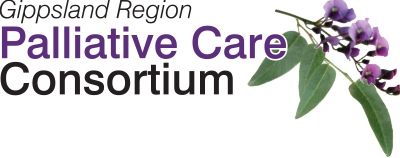
Clinical Practice Group Guidelines
The following documents have been developed by the Gippsland Region Clinical Practice Group to assist health professionals and palliative care service providers develop their own policies and procedures around palliative care.
-
The Advance Care Planning Guidelines support clinical staff to “have the conversation” with clients and caregivers about end of life decision making, engage clients and their families in decisions about their care and help them to undertake advance care planning.
Click here to download.
-
Breathlessness Guidelines and Flowchart is used to assist in assessment and management of difficult or uncomfortable breathing.
Click here to download.
-
The Clinical Care Guidelines were developed by Banksia Palliative Care and modified for use in Gippsland.
Click here to download.
-
The Clinical Supervision and Support Guideline describes clinical supervision options and provides a guide for organisations to support staff and volunteers appropriate to the individual and their scope of practice to access supervision, should they choose to do so.
Click here to download.
-
When an imminently dying patient expresses a wish to die at home, their request should not be simply viewed as impractical or impossible. Rather, a realistic evaluation of the feasibility of different options should be undertaken.
Click here download.
-
Drug Compatibility in Subcutaneous Infusions Chart is a printable colour pictorial chart with indicators of drug compatibility.
Click here to download.
-
The Management of clients with automatic defibrillators and pacemakers at end of life guideline provides best practice guidelines for the deactivation of ICDs in hospital and community settings.
Click here to download.
-
The Opioid Conversion Guidelines outline Equianalgesic dose conversions, which are necessary when changing opioid drug therapy in the clinical setting.
Click here to download.
-
In patients with oxygen saturation at rest of ≤ 90%, a therapeutic trial of oxygen therapy may be reasonable but continued use can only be justified if there is therapeutic benefit.
Click here to download the guideline.
-
Anticipatory prescribing is designed to enable prompt symptom relief at whatever time the client develops distressing symptoms.
Click here to download the Palliative Care Anticipatory Prescribing Guidelines.
-
A palliative care emergency is a sudden and life-threatening clinical change in a patient with a life-limiting illness. It requires timely identification, rapid assessment and prompt management to ensure, where possible, rapid reversal of symptoms to promote preservation of quality of life.
Click here to download the Palliative Care Emergencies guidelines.
-
The Palliative Care Triage and Transfer form is an electronic referral form template.
Click here to download.
-
Palliative Care Service Assess & Management Flow Chart for GP’s is used to inform clinical practice, policies and procedures in health services.
Click here to download.
-
The Palliative Sedation guideline is to guide the use of continuous palliative sedation therapy in clients undergoing end of life care.
Click here to download.
-
The 2 part psychosocial screening in palliative care setting and bereavement support in the palliative care setting guideline provides a framework to support generalist clinicians/services, across settings, to include screening for psychosocial distress as a part of palliative care assessment and provides support to staff in routine bereavement care, and to identify triggers for consideration of specialist bereavement care when necessary.
Click here to download
-
This Rapid admission for imminently dying patients from the community palliative care to inpatient setting flowchart guides the process for an imminently dying registered community palliative care patient in need of direct admission to hospital.
Click here to download.
-
The Recommendations for the Care of Patients with Malignant Fungating Wounds document supports best practice among nurses who manage such wounds, based on current literature and experiences.
Click here to download.
-
The Self care and wellbeing in the palliative care and end of life setting guidelines provide information on self-care options as a part of clinician wellbeing when working in a palliative care environment.
Click here to download.
-
The Symptom Control Algorithm is a companion document to the Care Plan for the Dying Person. It is based on the PICD algorithm and updated with the most recent evidence from the therapeutic guidelines and palliative care formulary.
Click here to download.
-
The symptom management for adult patients with COVID-19 receiving end-of-life supportive care outside ICU was adapted from BC Centre for Palliative Care Guidelines, edited with permission by the Gippsland Regional Palliative Care Consultancy Service GRPCCS team for use in Gippsland.
Click here to download.
-
The Verification and Certification of Death outlines the requirement that all patients within Gippsland will have a death certificate signed by a qualified Medical Practitioner within 48 hours of the death, unless they are required to report the death to the Coroner.
Click here to download.
GRPCC CPG Guideline Disclaimer: The intent of clinical guidelines endorsed and made available by the Clinical Practice Group of the GRPCC is to assist health services and clinical staff across the Gippsland region to facilitate evidence based practice in palliative care.
Clinical guidelines are intended to provide general advice to the medical, nursing, and allied health staff working with clients who have life limiting illness. They should never be relied on as a substitute for proper assessment with respect to the particular circumstances of each case and the needs of each patient or organisation.
Whilst the GRPCC endeavours to ensure these clinical guidelines are accurate at the time of their preparation, it takes no responsibility for matters arising from changed circumstances or information or material that may have become available after the issued or reviewed date.
Organisations and health care professionals should ensure that in using the GRPCC guidelines that they are complementary to their current organisational governance structures, and individual clinicians scope of practice.
